Structural Stability
1926.754 Structural Steel Assembly
1926.755 Column Anchorage
1926.756 Beams and columns
1926.757 Open web steel joists
1926.754
Structural steel assembly
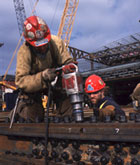
Since structural collapse is second only to falls as a cause of fatalities in this industry, stability is essential to the successful erection
of any steel structure, including single- story, multi-story, bridges, etc. This section of the standard outlines the work practices that will
prevent collapse due to lack of stability. In addition, it addresses slipping/tripping hazards and certain kinds of fall hazards encountered
when working on steel structures.
-
Permanent floors must be
installed as the erection of structural
members progresses, with no more than
eight stories between the erection
floor and the upper-most permanent floor [1926.754(b)(1)].
-
Unfinished bolting or welding
above the foundation (or the uppermost
secured floor) is not permitted to
exceed
-
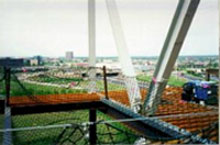 Exceptions are allowed where
structural integrity is accounted for in the design. Exceptions are allowed where
structural integrity is accounted for in the design.
-
Safety nets or a fully planked or
decked floor must be maintained
directly under any erection work being
performed, within
-
two stories, or
-
30 feet (9.1 m), whichever is less
[1926.754(b)(3)].
-
Exception: Not required if personal fall arrest systems are used at all
times above 15 feet [CPL2-1.34,
Q&A 23]
|
-
To prevent tripping hazards, the
following components must not be
attached so as to project from the top
flanges of beams, joists, or beam
attachments until after the metal
decking, or other walking/working surface, has been installed:
-
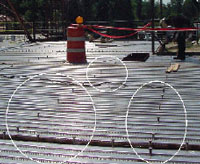 shear connectors (such as headed
steel studs, steel bars, or steel
lugs), shear connectors (such as headed
steel studs, steel bars, or steel
lugs),
-
reinforcing bars,
-
deformed anchors, and
-
threaded studs [1926.754(c)(1)(i)].
-
Exception: These may be factory installed if all workers, including
connectors and deckers, use fall protection at all times [CPL2-1.34, Q&A
25]
-
When shear connectors are used
in construction of composite floors,
roofs and bridge decks, they must be
laid out and installed after the metal
decking has been installed, so the
metal decking serves as a working
platform [1926.754(c)(1)(ii)].
-
Shear connectors may not be installed
from within a controlled decking
zone (CDZ) [1926.760(c)(7)].
-
Workers will not be permitted to walk
the top surface of any structural
steel member installed after July 18,
2006 that has been coated with paint or
similar material, unless all of the following are met:
-
The coating has achieved a
minimum average slip
resistance of .50 in laboratory tests.
-
The tests were based on the
appropriate ASTM standard test
method and conducted by a
qualified laboratory (Appendix B to
this subpart references appropriate
ASTM standard test methods).
- Documentation of the test
results is available at the site
and to the steel erector [1926.754(c)(3)].
|
-
When deemed necessary by a competent
person, plumbing-up equipment
must be installed during the steel
erection process to ensure the
stability of the structure [1926.754(d)(1)].
-
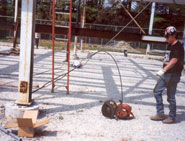 When plumbing-up equipment is used, it
must be in place and properly
installed before the structure is
loaded with construction material such
as loads of joists, bundles of decking,
or bundles of bridging [1926.754(d)(2)].
When plumbing-up equipment is used, it
must be in place and properly
installed before the structure is
loaded with construction material such
as loads of joists, bundles of decking,
or bundles of bridging [1926.754(d)(2)].
-
Plumbing-up equipment may be removed
only with the approval of a
competent person [1926.754(d)(3)].
|
Hoisting, landing, and placing of metal decking bundles
-
Bundle packaging and strapping
may not be used for hoisting unless
specifically designed for that purpose
[1926.754(e)(1)(i)].
-
If loose items such as dunnage,
flashing, or other materials are placed
on top of metal decking bundles
intended to be hoisted, they must be
secured to the bundles [1926.754(e)(1)(ii)].
-
When bundles of metal decking are
landed on joists, all bridging must
be installed and anchored, and all
joist- bearing ends attached [1926.754(e)(1)(iii)].
(See Open web steel joists for exceptions.)
-
Metal decking bundles must be landed
on framing members so that enough
support is provided to allow the
bundles to be unbanded without
dislodging the bundles from the supports [1926.754(e)(1)(iv)].
-
At the end of the shift or when
environmental or jobsite conditions
require, metal decking must be
secured against displacement [1926.754(e)(1)(v)].
Roof and floor holes and openings
- Metal decking at roof and floor holes and openings must be installed as follows:
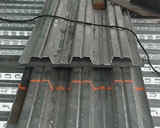
- Framed metal deck openings must have structural members turned down to allow continuous deck
installation, except where prevented by structural design constraints or constructibility [1926.754(e)(2)(i)].
- Openings such as roof and floor holes must be decked over.
- Where large size, configuration, or other structural constraints do not allow openings to be decked over (e.g. elevator shafts, stair wells,
etc.), employees must be protected in accordance with the fall protection provisions of
this standard [1926.754(e)(2)(ii)].
-
When
metal decking holes and openings
are cut, they must
Covering roof and floor openings
-
Covers for roof and floor
openings shall be capable of
supporting, without failure, twice the
weight of the employees, equipment, and
materials that may be imposed on them
at any one time [1926.754(e)(3)(i)].
-
 All covers must be:
All covers must be:
-
Secured when installed to
prevent accidental displacement by
the wind, equipment or employees
[1926.754(e)(3)(ii)], and
-
Painted with high-visibility paint, or
-
Marked with the word "HOLE"
or "COVER" to provide warning of
the hazard [1926.754(e)(3)(iii)].
-
Installed smoke dome or skylight
fixtures are not considered covers,
unless they meet the appropriate
strength requirements [1926.754(e)(3)(iv)].
-
Where planks or metal decking around
columns do not fit tightly, wire
mesh, exterior plywood, or equivalent
material must be installed, and must be
of sufficient strength to:
-
provide fall protection for
personnel, and
-
prevent objects from falling
through [1926.754(e)(4)].
Installation of metal decking
Derrick Floors
-
To support the intended floor
loading, a derrick floor must be
fully decked and/or planked, and the
steel member connections completed [1926.754(e)(6)(i)].
-
Temporary loads placed on a
derrick floor must be distributed over
the underlying support members so as to
prevent local overloading of the deck
material [1926.754(e)(6)(ii)].
|
1926.755
Column anchorage

This section addresses the hazards associated
with column stability and, specifically, the
proper use of anchor rods (anchor bolts) to
ensure column stability. Inadequate anchor
rod/bolt installation has been identified as a
primary contributing factor to structural
collapses.
-
All columns must be anchored by
a minimum of 4 anchor rods
(anchor bolts). [1926.755(a)(1)]
-
Each column anchor rod (anchor
bolt) assembly, including the
column-to-base plate weld and the
column foundation, must be designed to
[1926.755(a)(2)]:
-
resist a minimum eccentric gravity
load of 300 pounds located 18 inches from
the extreme outer face of the
column in each direction at the top of the column
shaft.
-
Columns must be set on [1926.755(a)(3)]:
-
level finished floors,
-
pre-grouted leveling
plates,
-
leveling nuts, or
-
shim packs
that adequately
transfer the construction loads.
-
All columns must be evaluated by a
competent person to determine
whether guying or bracing is
needed; if guying or bracing is needed,
it must be installed. [1926.755(a)(4)]
|
-
Approval by the project structural
engineer of record is required
before anchor rods (anchor bolts) can be [1926.755(b)(1)]:
-
repaired,
-
replaced, or
-
field-modified.
-
Before the erection of a column, the
controlling contractor must provide
written notification to the
steel erector if there has been
any:
-
repair,
-
replacement, or
-
modification of the anchor rods of
that column. [1926.755(b)(2)]
|
1926.756
Beams and columns
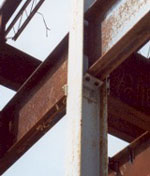
Inappropriate or inadequate connections of beams
and columns is hazardous and can lead to
collapses and worker fatalities. This section
sets forth performance and specification
requirements for connecting beams and columns, in
order to minimize the hazard of structural
collapse during the early stages of the steel
erection process.
-
During the final placing of solid web
structural members, the load must not
be released from the hoisting
line until [1926.756(a)(1)]:
-
the members are secured with at
least two bolts per connection,
of the same size and strength as
shown in the erection drawings;
-
these bolts are drawn up
wrench-tight; or
-
the equivalent, as specified by the
project structural engineer of
record, except as specified in
1926.756(b) of this section.
-
A competent person must
determine if more than two bolts are
necessary to ensure the stability of
cantilevered members; if
additional bolts are needed, they must
be installed. [1926.756(a)(2)]
|
-
Solid web structural members used as
diagonal bracing must be
secured by [1926.756(b)]:
-
at least one bolt per
connection drawn up
wrench-tight; or
-
the equivalent, as specified by the
project structural engineer of
record.
|
-
When two structural members on opposite
sides of a column web, or a beam web
over a column, are connected sharing
common connection holes:
-
at least one bolt with its
wrench-tight nut must remain
connected to the first
member; unless
-
a shop-attached, or
field-attached seat or
equivalent connection
device is supplied with the member in order to:
-
secure the first member,
and
-
prevent the column from being
displaced [1926.756(c)(1)]. (See Appendix
H to this subpart for examples
of equivalent connection
devices.)
-
If a seat or equivalent device is used:
-
the seat (or device) must be
designed to support the load
during the double connection
process; and
-
before the nuts on the shared bolts
are removed to make the double
connection, it must be
adequately bolted or welded
to both:
|
-
Each column splice must be:
-
designed to resist a minimum
eccentric gravity load of 300
pounds, and
-
located 18 inches from the
extreme outer face of the column in
each direction, and
-
located at the top of the column shaft [1926.756(d)].
|
-
Perimeter columns must not be
erected unless:
-
They extend a minimum of 48
inches above the finished
floor, to permit installation of
perimeter safety cables prior to
erection of the next story [1926.756(e)(1)], and
-
They have two sets of
holes, or other devices that:
-
are 42-45 inches above the
finished floor, and also at
the midpoint between the
finished floor and the top
cable, and
-
permit installation of
perimeter safety cables
as required by 1926.760(a)(2) [1926.756(e)(2)]
-
Exception: Where
constructability does not allow, the
above requirements can be waived. (See
Appendix F to this Subpart.)
|
1926.757
Open web steel joists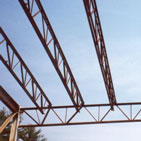
Some of the most serious risks facing the
ironworker are encountered during the erection of
open web steel joists, particularly landing loads
on unbridged joists and improperly placing loads
on joists. Based on a recent analysis of OSHA
data, more than half of ironworker fatalities due
to collapse are related to the erection of steel
joists.
-
Where steel joists are used and columns are not
framed in at least two directions with solid web structural steel members, the
columns must be made
laterally stable during erection by field-bolting the
steel joist at the column. (See exception below.) [1926.757(a)(1)]
-
When installing the stabilizing joist:
|

View
Accident Report
|
-
a vertical stabilizer plate
for steel joists must be provided on each column, which must:
-
be at least 6 inches by 6
inches,
-
extend at least 3 inches
below the bottom chord of
the joist, and
-
have a 13/16-inch hole
to provide an attachment point
for guying or plumbing cables [1926.757(a)(1)(i)];
-
the bottom chords must be
stabilized to prevent
rotation during erection [1926.757(a)(1)(ii)]; and
-
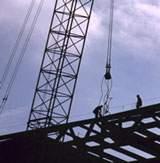 hoisting cables must not be
released until:
hoisting cables must not be
released until:
-
the seat at each end of the
steel joist is field-bolted,
and
-
each end of the bottom chord is
restrained by the column
stabilizer plate. [1926.757(a)(1)(iii)]
- Exception: Where
constructability does not allow a steel
joist to be installed at the column:
- an alternate means of
stabilizing joists must be
installed on both sides near the
column and it must [1926.757(a)(2)(i)]:
-
hoisting cables must not be
released until the seat at each end
of the steel joist is field-bolted
and the joist is stabilized. [1926.757(a)(2)(ii)]
-
Where steel joists at or near columns span 60 feet or
less:
- the joist must be designed with
sufficient strength to allow
one employee to release the
hoisting cable without the need for
erection bridging [1926.757(a)(3)].
- Alternatively, procedures described in the Compliance Directive may be used
instead until July 18, 2003 [CPL
2-1.34, Q&A 32].
- Where steel joists at or near columns span more than 60
feet:
- the joists need to be set in
tandem with all bridging
installed [1926.757(a)(4)], or
- an alternative method of
erection may be used, which [1926.757(a)(4)]:
- provides equivalent
stability to the steel
joist,
- is designed by a qualified
person, and
- is included in the
site-specific erection
plan.
- A steel joist or steel joist girder
must not be placed on any support
structure that is not
stabilized. [1926.757(a)(5)]
- When steel joists are landed on a
structure, they must be secured to
prevent unintentional
displacement prior to installation.
[1926.757(a)(6)]
- Any modification that affects
the strength of a steel joist or steel
joist girder must be made with the
approval of the project structural
engineer of record.[1926.757(a)(7)]
- When connecting individual steel joists
to steel structures in bays 40 feet
or longer (see exception below):
- the connections must be fabricated to
allow for field-bolting
during erection [1926.757(a)(8)(i)], and
- the connections must be initially field-bolted unless
constructability does not
allow. [1926.757(a)(8)(ii)]
-
Exception: These
requirements do not apply when
steel joists are
pre-assembled into panels.
[1926.757(a)(8)(i)]
-
Steel joists and steel joist girders
must not be used as anchorage points
for a fall-arrest system unless
written approval to do so is obtained
from a qualified person. [1926.757(a)(9)]
-
A bridging terminus point must
be established before bridging is installed. [1926.757(a)(10)]
|
-
Each end of "K" series steel
joists must be finally attached to the
support structure with a minimum of:
-
two 1/8-inch fillet welds 1
inch long,
-
two 1/2-inch bolts,
or
-
an equivalent connection. [1926.757(b)(1)]
-
Each end of "LH" and "DLH" series
steel joists and steel joist
girders must be finally attached to the support
structure with a minimum of:
-
two 1/4-inch fillet
welds 2 inches long,
-
two 3/4-inch bolts,
or
-
an equivalent connection. [1926.757(b)(2)]
-
Except for panelized joists, each steel joist must be attached to
the support structure, with at
least one end on both sides of the
seat:
-
immediately upon placement in the
final erection position,
and
-
before additional joists are
placed. [1926.757(b)(3)]
-
Panels that have been
pre-assembled from steel joists
must be attached with bridging to the
structure at each corner before the
hoisting cables are released. [1926.757(b)(4)]
|
-
For steel joists in Tables A and B
that require
bridging,
-
attach both sides of the
seat of one end of each steel
joist to the support structure
before hoisting cables are
released. [1926.757(c)(1)]
-
For joists over 60 feet [1926.757(c)(2)]
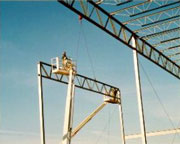 , ,
-
Only one employee is allowed on
steel joists that do not require
erection bridging under Tables A and B,
until all bridging is installed and
anchored. [1926.757(c)(3)]
-
Employees are not allowed on
steel joists where the span of the
steel joist is equal to or greater than
the span shown in Tables A and B except
in accordance with Erection Bridging provisions. [1926.757(c)(4)]
-
When permanent bridging terminus points
cannot be used during erection,
additional temporary bridging
terminus points are required to
provide stability. [1926.757(c)(5)]
|
-
Where the span of the steel
joist is equal to or greater than
the span shown in Tables A and B, the
following applies:
-
A row of bolted diagonal
erection bridging must be
installed near the mid-span of the
steel joist [1926.757(d)(1)(i)]
;
-
Hoisting cables must not be
released until this bolted
diagonal erection bridging is
installed and anchored [1926.757(d)(1)(ii)]; and
-
No more than one employee is
allowed on these spans until
all other bridging is installed and
anchored [1926.757(d)(1)(iii)].
-
Where the span of the steel joist is
60 feet through 100 feet, the
following applies:
-
All rows of bridging must be
bolted diagonal bridging [1926.757(d)(2)(i)];
-
Two rows of bolted diagonal
erection bridging must be installed
near the third points of the
steel joist (e.g. 1/3
joist-length) from each end [1926.757(d)(2)(ii)];
-
Hoisting cables must not be
released until this bolted diagonal
erection bridging is installed and
anchored [1926.757(d)(2)(iii)]; and
-
No more than two employees
are allowed on these spans until
all other bridging is installed and
anchored [1926.757(d)(2)(iv)].
-
Where the span of the steel joist is
100 feet through 144 feet, the
following applies:
-
All rows of bridging must be
bolted diagonal bridging [1926.757(d)(3)(i)];
-
Hoisting cables must not be
released until all bridging is
installed and anchored [1926.757(d)(3)(ii)]; and
-
No more than two employees
are allowed on these spans until
all bridging is installed and
anchored [1926.757(d)(3)(iii)].
-
For steel members spanning over 144
feet, the erection methods used
must be in accordance with 1926.756. [1926.757(d)(4)]
-
Where any steel joist that requires bridging is a bottom
chord bearing joist [1926.757(d)(5)],
-
a row of bolted diagonal
bridging must be provided near
the supports; and
-
this bridging must be installed and
anchored before the hoisting
cables are released.
-
When bolted diagonal erection
bridging is required, the following applies:
-
the bridging must be indicated on
the erection drawing [1926.757(d)(6)(i)];
-
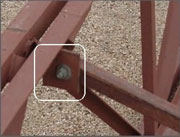 the erection drawing must be the
exclusive indicator of the
proper placement of this
bridging [1926.757(d)(6)(ii)];
the erection drawing must be the
exclusive indicator of the
proper placement of this
bridging [1926.757(d)(6)(ii)];
-
shop-installed bridging
clips, or functional
equivalents, must be used where the
bridging bolts to the steel joists
[1926.757(d)(6)(iii)].
-
When two pieces of bridging are
attached to the steel joist by a
common bolt, the nut that
secures the first piece of bridging
must not be removed from the bolt
in order to attach the second [1926.757(d)(6)(iv)]; and
-
bridging attachments must not
protrude above the top chord
of the steel joist [1926.757(d)(6)(v)].
|
-
During
the construction period, the employer placing a load on steel joists must ensure
that the load is distributed so as not to exceed the
carrying capacity of any steel joist. [1926.757(e)(1)]
-
Except as noted below, no
construction loads are allowed on the steel joists
until all bridging is installed and anchored and all joist-bearing ends are
attached. [1926.757(e)(2)]
-
The weight of a bundle of joist bridging must not exceed a total of
1,000 pounds, and [1926.757(e)(3)]:
-
a bundle of joist bridging must be
placed on a minimum of three
steel joists that are secured
at one end, and
-
the edge of the bridging bundle must be within 1 foot
of the secured end.
-
No bundle of decking may be placed on steel joists until [1926.757(e)(4)]:
-
all bridging has been installed
and anchored, and
-
all joist bearing ends are
attached, unless all of the following conditions are met:
- the employer has first determined that the structure or portion of the
structure is
capable of supporting the
load. This determination must be made:
-
by a qualified
person, and
-
documented in a site-specific erection
plan [1926.757(e)(4)(i)];
-
the bundle of decking is placed on a minimum of three steel
joists [1926.757(e)(4)(ii)];
-
the joists supporting the bundle of decking are
attached at both ends
[1926.757(e)(4)(iii)];
-
at least one row of bridging
is installed and anchored
[1926.757(e)(4)(iv)];
-
the total weight of the bundle
of decking does not exceed
4,000 pounds [1926.757(e)(4)(v)]; and
-
placement of the bundle of decking is within 1 foot
of the bearing surface of the joist end [1926.757(e)(4)(vi)].
- The edge of any construction load must be placed within 1 foot of the
bearing surface of the joist end [1926.757(e)(5)].
|
|
|
|
|

